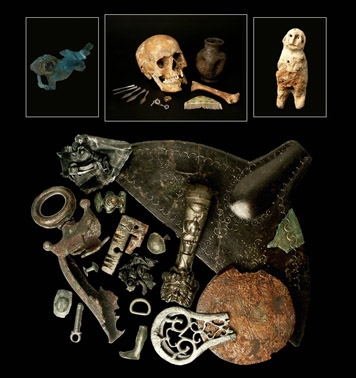Frienstedt, Middle Germany
Christoph G. Schmidt M.A.
Modelled on the enemy? Germanic elite under Roman impact
 On 1st November 2009, a two-year research project began, dedicated to the Roman Iron Age site of Frienstedt, near Erfurt; the project is sponsored by the Fritz-Thyssen Foundation. This site, approximately half of which was excavated between 2000 and 2003, comprises an artisans’ settlement with clear evidence for the working of non-ferrous and precious metals, together with extremely abundant material remains of Roman provenance. There are also 11 inhumation graves of the Haβleben-Leuna group as well as a presumed cult site. This rare combination permits investigations, on the one hand, into the social structure and formation of a regional elite in the Barbaricum during the Late Roman Iron Age and, on the other, into questions relating to the economic, technological and cultural influences from the Roman Empire and their possible political background, especially during the 3rd century AD.
On 1st November 2009, a two-year research project began, dedicated to the Roman Iron Age site of Frienstedt, near Erfurt; the project is sponsored by the Fritz-Thyssen Foundation. This site, approximately half of which was excavated between 2000 and 2003, comprises an artisans’ settlement with clear evidence for the working of non-ferrous and precious metals, together with extremely abundant material remains of Roman provenance. There are also 11 inhumation graves of the Haβleben-Leuna group as well as a presumed cult site. This rare combination permits investigations, on the one hand, into the social structure and formation of a regional elite in the Barbaricum during the Late Roman Iron Age and, on the other, into questions relating to the economic, technological and cultural influences from the Roman Empire and their possible political background, especially during the 3rd century AD.
Within the framework of examination assignments, student assistants will evaluate the closed ceramic find complexes as the basis for an empirically constructed chronology. And in the laboratories of the project’s co-partner, Thüringisches Landesamt für Denkmalpflege und Archäologie (TLDA) in Weimar, material analyses will provide new clues relating to the ceramic and metal technology, and in particular to Central German hand-thrown wares, made on a potter’s wheel. Evidence from settlement remains and grave finds, together with that provided by the numerous metal finds, will eventually form the basis for a doctoral thesis and publication, in which the individual areas of work will be brought together and synthesised.
The published dissertation online:
https://macau.uni-kiel.de/receive/dissertation_diss_00023264
Research clusters
Man and Society
Research Priorities
Beyond the Grave
Staff
Christoph G. Schmidt
In cooperation with
Thüringisches Landesamt für Denkmalpflege und Archäologie (TLDA) in Weimar